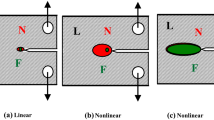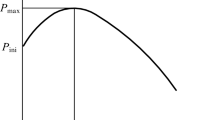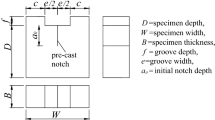Abstract
The results of experimental investigations using laser speckle interferometry on small size three-point bending notched beams and using photoelastic coating and the strain gauges on very large size compact tension specimens of concrete are presented in detail. The investigations showed that there exists a stage of stable crack propagation before unstable fracture occurs. The results are in agreement with other researchers' investigations using moire interferometry, holographic interferometry, dye-impregnation method and microscope. Further detailed study shows that the three different states, i.e., crack initiation, stable crack propagation and unstable fracture can be distinguished in the fracture process in concrete structures. In order to predict the crack propagation during the fracture process in quasi-brittle materials a double-K criterion is proposed. The double-K criterion consists of two size-independent parameters. Both of them are expressed in terms of the stress intensity factors. One of them reflects the initial cracking toughness, denoted with Kini, which can be directly evaluated by the initial cracking load, Pini, and the precast crack length, a0, using a formula of LEFM. The other one refers to the unstable fracture toughness, denoted with Kun, which can be obtained inserting the maximum load, Pmax, and the effective crack length, a, into the same formula of LEFM. The values of the two parameters, K iniIc and K unIc , obtained from the small size three-point bending notched beams and the large size compact tension specimens show that K iniIc and K unIc are size-independent. Evaluating with the K-resistance curves obtained from the same test data, it is found that the proposed double-K criterion is equivalent to it in basic principle, but, the double-K criterion can be applied more easily than the K-resistance curve. Finally, as a practical example, the application of the double-K criterion to the prediction of the crack propagation in a concrete dam is discussed.
Similar content being viewed by others
References
ASTM Special Committee on Fracture Testing of High-Strength Materials, ASTM Bulletin (1960), 29–40.
Bascoul, A., Kharchi, F. and Maso, J.C. (1989). Concerning the measurement of the fracture energy of a microconcrete according to the crack growth in a three points bending test on notched beams. Fracture of Concrete and Rock (Edited by S.P. Shah and S.E. Swartz), Springer-Verlag, New York, 396–408.
Bazant, Z.P. (1996). Analysis of work-of-fracture method for measuring fracture energy of concrete. Journal of Engineering Mechanics ASCE 122, 138–144.
Bazant, Z.P. and Oh, B.H. (1983). Crack band theory for fracture of concrete. RILEM, Materials and Structures 16(93), 155–177.
Bazant, Z.P., Kim, J.K. and Pfeiffer, P.A. (1986). Determination of fracture properties from size effect tests. Journal of Structural Engineering. ASCE, 112(2), 289–307.
Davies, J. (1995). Study of shear fracture in mortar specimens. Cement and Concrete Research 25(5), 1031–1042.
Du, J.J., Kobayashi, A.S. and Hawkins, N.M. (1989). An experimental-numerical analysis of fracture process zone in concrete fracture specimens. Engineering Fracture Mechanics 35(1/2/3), 15–27.
Hillerborg, A. (1985). Results of three comparative test series for determining the fracture energy G F of Concrete. Ibid. 18(107), 407–413.
Hillerborg, A., Modeer, M. and Petersson, P.E. (1976). Analysis of crack formation and crack growth in concrete by means of fracture mechanics and finite elements. Cement and Concrete Research 6, 773–782.
Irwin, G.R. and Kies, J.A. (1954). Welding Research Supplement 19, 193–198.
Jenq, Y.S. and Shah S.P. (1985). Two parameter fracture model for concrete. Journal of Engineering Mechanics, ASCE, 111(10), 1227–1241.
John, R. and Shah, S.P. (1986). Fracture of concrete subjected to impact loading. Journal of Cement and Concrete Aggregation 8(1), 24–32.
Karihaloo, B.L. and Nallathambi, P. (1990). Effective crack model for the determination of fracture toughness (K sIc ) of concrete. Engineering Fracture Mechanics 35(4/5), 637–645.
Karihaloo, B.L. and Nallathambi, P. (1991). Notched beam test: Mode I fracture toughness. Fracture Mechanics Test Methods for Concrete, Report of RILEM Technical Committee 89-FMT (Edited by S.P. Shah and A. Carpinteri), Chapman & Hall, London, 1–86.
Kaplan, M.F. (1961). Crack propagation and the fracture of concrete. Journal of ACI 58(5), 591–610.
Karihaloo, B.L. (1989). Do plain and fiber-reinforced concretes have an R-curve behavior? Fracture of Concrete and Rock (Edited by S.P. Shah and S.E. Swartz), Springer-Verlag, New York, 96–105.
Mai, Y.W. (1984). Fracture measurements of cementitious composites. Application of Fracture Mechanics to Cementitious Composites (Edited by S.P. Shah), NATOARW, 399–429.
Pflug, L. (1979). Proceedings of 7th National Congress of the Italian Society for stress Analysis, Supplement, Cagliari, A.I.A.S., 5–26.
Refai, T.M.E. and Swartz, S.E. (1987). Fracture Behavior of Concrete Beams in Three-Point Bending Considering the Influence of Size Effects. Report No. 190, Engineering Experiments Station, Kansas State University.
RILEM Technical Committee 50-FMC (1985). Determination of the fracture energy of mortar and concrete by means of three-point bend tests of notched beams, proposed RILEM draft recommendations. RILEM, Materials and Structures 18(106), 285–296.
RILEM Technical Committee 89-FMT (1990a). Determination of fracture parameters (K sIc and CTODc) of plain concrete using three-point bend tests, proposed RILEM draft recommendations. Ibid. 23(138), 457–460.
RILEM Technical Committee 89-FMT (1990b). Size-effect method for determining fracture energy and process zone size of concrete, proposed RILEM draft recommendations. Ibid. 23(138), 461–465.
Ripling, E.J. and Falkenstein, E. (1973). Measuring K R-curves for thin sheets. Fracture Toughness Evaluation by R-Curve Methods ASTM STP 527, American Society for Testing and Materials, 36–47.
Saouma, V.E., Broz, J.J., Brühwiler, E. and Boggs, H.L. (1991). Effect of aggregate and specimen size of fracture properties of dam concrete. ASCE, Journal of Materials in Civil Engineering 3(3), 204–218.
Srawley, J.E. and Gross, B. (1972). Stress intensity factors for bend and compact specimens. Engineering Fracture Mechanics 4, 587.
Tada, H., Paris, P.C. and Irwin, G.R. (1985). The Stress Analysis of Cracks Handbook. Paris Productions Incorporated, St. Louis, Missouri, USA.
Tang, T.X., Ouyang, C.S. and Shah, S.P. (1995). A Simple Method for Determining Material Fracture Parameters from Peak Loads. NSF Center for Science and Technology of Advanced Cement-Based Materials, Northwestern University, Evanston, Illinois, USA.
Wittmann, F.H. and Mihashi, H. and Nomura. Size effect on fracture energy of concrete. Engineering Fracture Mechanics 35(1/2/3), 107–115.
Xu, Shilang. (1988). The Fracture Mechanism of Concrete. Ph.D. Thesis (in Chinese), Dalian University of Technology, Dalian, China.
Xu, Shilang and Zhao, Guofan (1989a). A study on fracture process zones in concrete by means of laser speckle photography. Brittle Matrix Composites 2 (Edited by A.M. Brandt and I.H. Marshall), Elsevier Applied Science, London, 333–341.
Xu, Shilang and Zhao, Guofan (1989b). The stable propagation of crack in concrete and the determination of critical crack tip opening displacement. Journal of Hydraulic Engineering (in Chinese), Beijing (4), 33–44.
Xu, Shilang and Zhao, Guofan (1989c). Determination of fracture toughness and the fracture energy of concrete. Fracture Toughness and Fracture Energy (Edited by H., Mihashi et al.), Balkema, Rotterdam, 197–203.
Xu, Shilang and Zhao, Guofan (1991a). Researches on the Fracture Mechanics of Concrete (in Chinese). The Press of Dalian University of Technology, Dalian, China.
Xu, Shilang and Zhao, Guofan (1991b). Concrete fracture toughness of huge specimens and criterion of fracture toughness for judging cracks in high concrete dam. China Civil Engineering Journal (Quarterly, in Chinese), Beijing 24(2), 1–9.
Xu, Shilang and Zhao, Guofan (1991c). The investigation on the propagation process of a crack in the concrete by means of photoelastic coatings. Journal of Hydraulic Engineering (Quarterly, in Chinese), Beijing (3), 8–18.
Xu, Shilang et al. (1991d). Fracture energy and strain field near the tip of a notch in huge concrete specimen under compact tension. Ibid. (11), 17–25
Xu, Shilang, Reinhardt, H.W. and Gappoev, M. (1996). Mode II fracture method for highly orthotropic materials like wood. International Journal of Fracture 75, 185–214.
Xu, Shilang. (1982). Analysis and test on the fracture toughness of concrete. Journal of Hydraulic Engineering (in Chinese), Beijing (6), 51–56.
Zandman, F., Redner, S. and Dally, J.W. (1977). Photoelastic coatings. Society for Experimental Stress Analysis Monograph (3), SESA, The Iowa State University Press, Ames, Iowa, USA.
Zhao, Zhongji (1982). Fracture mechanical analysis of horizontal crack on the upstream face and heel of gravity dams. Journal of Hydraulic Engineering (in Chinese), Beijing (6), 51–56.
Zhao, Guofan, Hui, Jiao and Xu, Shilang (1991). Study on fracture behavior with wedge splitting test method. Fracture Process in Concrete, Rock and Ceramics (Edited by J.G.M. van Mier et al.), RILEM Proceedings 13, E & FN Spon, London, 789–799.
Author information
Authors and Affiliations
Rights and permissions
About this article
Cite this article
Xu, S., Reinhardt, H.W. Determination of double-Determination of double-K criterion for crack propagation in quasi-brittle fracture Part I: experimental investigation of crack propagation. International Journal of Fracture 98, 111–149 (1999). https://doi.org/10.1023/A:1018668929989
Issue Date:
DOI: https://doi.org/10.1023/A:1018668929989




